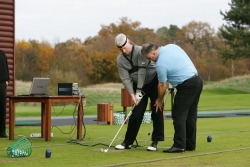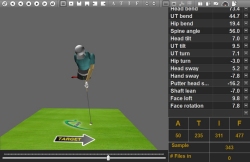The 3D Golf BioDynamics System
A Typical 3D Session with TGA
We hope you're already convinced of the benefits of 3D analysis and training with TGA but if not, take a look at the rest of this section or get in touch to find out more.
So what do you actually get from your 3D session with Total Golf Analysis? Read on ...
3D Analysis

Warm-Up and Setup
We would certainly like to see you warmed up before your session with us, so that the data collected is typical of your usual game/issues.
Before we can collect any data, we first need to attach sensors to your left hand, left arm, head, torso and pelvis with a series of straps/harnesses for our 'standard model'. An additional sensor will be attached to your club/putter if we are running the 'club and body' or 'putting' module.
Once this is done we will need to calibrate you to the system, which itself is calibrated to a specified target. This involves 'digitising' your body segments using a calibration pointer to mark many anatomical points. This is a much more accurate way of letting the system recognise where the segments are in space than the old 'snap calibration' method. Using this method we track the segment that the sensor is attached to and not the sensor itself which, given the huge variances in body shapes, allows for more accurate data collection.
Data Capture
After a few shots to acclimatise you to the feeling of wearing the harnesses, we will then capture several shots (usually five) and can then run a report on either an average of the captured swings or any individual swing. This is usually a good time to compare the report and animation to video capture from the same session and also to run some range tests to see if there are any restrictions or instabilities that may relate to any of the issues present.
Biofeedback
The next part of your session is what really separates the Golf BioDynamics system to the vast majority of its competitors. The 'biofeedback' facility that we have will allow you to 'feel' the changes that are required to make your swing more efficient, greatly reducing the time required to learn a new movement pattern. Biofeedback is when we set a corridor relating to an area that a body segment needs to move into and an audible tone sounds when you achieve that.
Reporting Back
We will finish the session by capturing a few more swings and running an after-biofeedback report to confirm if any of the changes suggested have been achieved. You will be able to run a free GBD program to view your own animation files and compare your progress over time and compare that to the recommendations at the top of each report, which will direct your practice/training until your next session.
Biofeedback Training
Once you have had a session either for data collection or a typical one hour session it is possible to use the biofeedback property of the system to enhance your practice session and continue to develop the feels required to re-enforce the work done in your previous sessions. We can attach the sensors, calibrate you to the system, set the biofeedback parameters and leave you to rehearse the body and swing drills to make your session more productive.

3D Putting Analysis
There are several key differences between the Golf BioDynamics putting module and its competitors:
Firstly, it's completely mobile and, being an electromagnetic system, can be used both indoors and outdoors with the results not being influenced by the wind. In fact, as long as the computer system is under cover, it can even be used in the rain. All we need is a straight putt in which to calibrate the system.
Secondly, we don't just analyse the putter, we also analyse the player! Biofeedback can be targeted on either to create a more efficient and consistent putting stroke. In partnership with one of today's high speed video cameras to analyse the roll of the ball, it really is the ultimate diagnostic tool for putting.
A sample of our 3D putting analysis report can be seen in our sample reports page.

